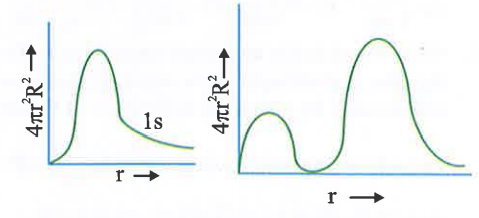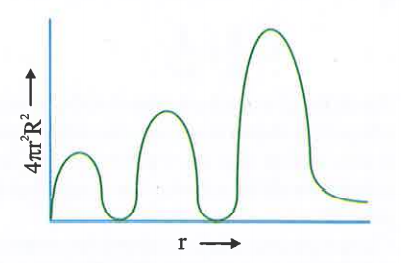For s-orbitals, since (Ψ orbitals wave function) is independent of angles, the probability density (Ψ2) is
also independent of angles
spherically symmetric
both (a) and (b) are correct
both (a) and (b) are incorrect
The correct Answer is:C
( c) For spherical orbital
Ψ=f(r)(r=distance from nucleus)
Since Ψ (orbital) is independent of angles therefore probability (Ψ2) also independent of angles and spherically symmetric.
Topper's Solved these Questions
- ATOMIC STRUCTUREBOOK - A2ZCHAPTER - ATOMIC STRUCTUREEXERCISE - Section B - Assertion Reasoning
34 Videos
- ATOMIC STRUCTUREBOOK - A2ZCHAPTER - ATOMIC STRUCTUREEXERCISE - AIPMT/NEET Questions
59 Videos
- ATOMIC STRUCTUREBOOK - A2ZCHAPTER - ATOMIC STRUCTUREEXERCISE - Heisenbergs Uncertainity Principle And Debroglie Equation
44 Videos
- CHEMICAL BONDING AND MOLECULAR STRUCTUREBOOK - A2ZCHAPTER - CHEMICAL BONDING AND MOLECULAR STRUCTUREEXERCISE - Section D - Chapter End Test
30 Videos
Similar Questions
Atomic Orbital wave function
View Solution24.Choose the correct statements from the following - A) A node is a point in space where the wave function ( Ψ ) has zero amplitude B) Total number of nodes in an orbital is equal to (n-1) C) Ψ2 represents the probability density of finding the electron D) Total no.of angular node in 2px orbital is one
View Solution
Knowledge Check
The Schrodinger wave equation for H-atom is
∇2Ψ=8π2mh2(E−V)Ψ=0
Where ∇2=∂2∂x2+∂2∂y2+∂2∂z2
E = Total energy and V=potential energy wave function Ψ(rθϕ)R(r)Θ(θ)Φ(ϕ)
R is radial wave function which is function of ''r'' only, where r is the distance from nucleus. Θ and Φ are angular wave function. R2 is known as radial probability density and 4πr2R2dr is known as radial probability function i.e., the probability of finding the electron is spherical shell of thickness dr.
Number of radial node =n -l - 1
Number of angular node = l
For hydrogen atom, wave function for 1s and 2s-orbitals are:
Ψ1s=√1πaa0e−zr/a0
Ψ2s=(Z2a0)½(1−Zra0)e−Zra0
The plot of radial probability function 4πr2R2 aganist r will be:

Answer the following questions:
The following graph is plotted for ns-orbitals

The value of 'n' will be:A1B2C3D4Assertion. The plots of probability density and radial probability function versus distance r from the nucleus for any particular orbital are not identical
Reason. Probability density is Ψ2 whereas radial probability function represents probability of finding the electron in a shell of thickness dr.AIf both assertion and reason are true, and reason is the true explanation of the assertionBIf both assertion and reason are true, but reason is not the true explanation of the assertionCIf assertion is true, but reason is falseDIf both assertion and reason are falseψ2 ,( psi) the wave function resperesents the probability of finding electron . Its value depends :
AHow much it is inside the nucleusBHow much it is far from the the nuycleusCHow much it is near the nucleusDUpon the type of orbital
Choose the correct statements from the following - A) A node is a point in space where the wave function (Ψ) has zero amplitude B) Total number of nodes in an orbital is equal to (n-1). C) Ψ2 represents the probability density of finding the electron D) Total no.of angular node in 2px orbital is one
View SolutionChoose the correct statements from the following:
(A) A node is a point in space where the wave function Ψ has zero amplitude.
(B) Total number of nodes in an orbital is equal to (n−1)
(C) Ψ2 represents the probability density of finding the electron
(D) Total no.of angular node in 2px orbital is one
View SolutionProbability density curve for 3s orbital
View SolutionPredict which of the following statements are true or false.
Ψ2 represents probability density .
View SolutionIn the Schrodinger's wave equation Ψ represents
View Solution
